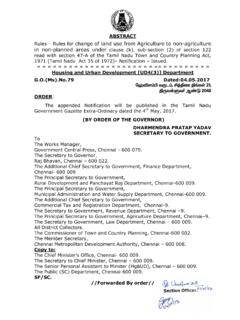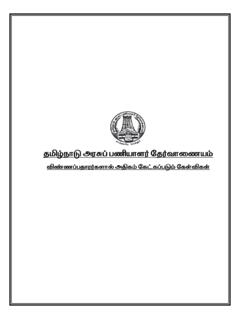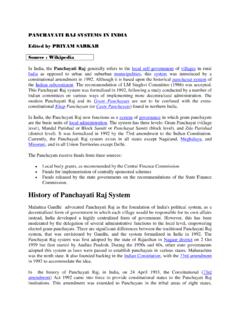Transcription of Chapter 10 Decentralization & Panchayati Raj Institutions ...
1 260 Chapter 10 Decentralization & Panchayati Raj Institutions (PRIs) It is more than seven years since the Constitution 73rd Amendment Act 1992 came into force. Most of the Panchayati Raj Institutions (PRIs) constituted under the new Act are completing their first five-year tenure. Therefore, it is an appropriate time for appraising the functioning of PRIs in different States so as to reflect on emerging trends and to identify the impediments that have emerged in the process of democratic decentralisation. 2. The status of PRIs can be reviewed in terms of following parameters: (i) Conduct of panchayat elections; (ii) Devolution of Financial Powers; (iii) Devolution of Functions and Functionaries; (iv) Constitution of District Planning Committees (DPCs); (v) Status of Gram Sabha; (vi) Act 40 of 1996; (vii) Checks and Balances over PRIs and Accountability 3.
2 Further, there are other issues which are central to the effectiveness of PRIs as conduits for delivery of economic and social services. These include participation, transparency and sustainability and the interface of PRIs with other parallel organisations operating at the local level. Conduct of panchayat Elections: 4. Except for Assam, Arunachal Pradesh, Bihar and Pondicherry, Panchayats have been constituted in all other States where they were to be set up according to the new provisions. For Arunachal Pradesh, the Ministry of rural development intends to introduce a bill for amending Article 243 D of the Constitution to exempt it from the requirement of providing for reservation of seats for Scheduled Castes.
3 This will provide a legal and Constitutional basis for PRIs in Arunachal Pradesh in accordance with the socio-demographic ethos of the State. In Bihar and Pondicherry, the elections to PRIs could not be held because the matter is sub-judice. Assam has cited law and order problems as a reason for not conducting panchayat elections that fell due in 1997. 5. As a result of election to PRIs in States/Union Territories, 2,27,698 Panchayats at village level, 5906 Panchayats at intermediate level and 474 Panchayats at the district level have been constituted in the country. These Panchayats are being manned by about 34 lakhs elected representatives at all levels; of them one-third are women. This is the broadest representative base that exists in any country in the world.
4 6. Elections to PRIs on expiry of their first term have been held in Haryana, Karnataka, West Bengal, Uttar Pradesh and Madhya Pradesh. 261 Devolution of Financial Powers to PRIs: 7. States where panchayats exist have constituted their respective State Finance Commissions (S FCs). Except for Sikkim and Goa, SFCs have submitted their reports to respective State Governments. Recommendations of the SFCs have been accepted in toto by ten States, viz; Karnataka, Kerala, Madhya Pradesh, Manipur, Punjab, Rajasthan, Tamil Nadu, Tripura, Uttar Pradesh and West Bengal. In case of Andhra Pradesh, Himachal Pradesh, Haryana and Maharashtra, the State Governments are still considering the reports. In Gujarat, the report is yet to be placed before the State Legislature.
5 The Government of Assam has accepted SFC's recommendations in part while the Orissa Government has accepted the report with some modifications. It would seem that the reports of SFCs have not attracted serious attention from many State Governments. The recommendations of the State Finance Commissions can be divided into three categories: (i) assignment of taxes, duties, levies and tolls to local bodies; (ii) sharing of revenue proceeds; and (iii) transfers on account of grants-in-aid and other financial assistance. As per the SFC recommendations, many of the State Governments have agreed to give PRIs a specific percentage of share in some of the State taxes like land revenue and cess on it, additional stamp duty, entertainment tax, royalties on minerals and mines, forest revenue and market fees; these taxes are less buoyant in nature and have no relation to the powers and functions to be devolved upon Panchayats.
6 More buoyant taxes like sales tax and excise are kept out of the purview of PRIs. All SFCs have put great emphasis on internal revenue mobilisation, but none has suggested any effective mechanism for PRIs to generate their own revenue. SFCs do not recommend or foresee any noticeable change in the tax (including the non-tax) jurisdiction of local bodies. However, the SFCs suggest better use of the existing tax jurisdiction by referring the system of property taxation and giving greater autonomy to local bodies in matters relating to tax rate setting. SFCs place greater reliance on transfers for bridging the gap between the local bodies revenue and expenditure. 8. In real terms, no improvement in local resource base is likely as a result of the recommendations of SFCs.
7 Moreover, the SFC reports have paid far less attention to issues of autonomy, financial management and auditing procedures. The main deficiency of the reports lies in the fact that the recommendations are not based on a clear statement of the spending responsibilities of local bodies. Indeed the absence of attention to the elementary principle, that expenditure assignment must precede any tax or revenue assignment, has made most of the SFC s recommendations suspect. 9. All PRIs have a poor fiscal base. While resource mobilisation by the PRIs is generally limited, it is imperative to provide PRIs with revenue raising powers of their own in order to reduce their excessive dependence on the State and Central Governments.
8 But till such time that they are financially dependent on funds from the State Governments, the State Budgets should specify the amount earmarked for district sector plans under Panchayati Raj as also their distribution among the three tiers. It is suggested that 30-40 percent of a State's Plan be devolved on local bodies as already done in the State of Kerala. In addition, a part of the finances should be in the form of untied funds so that the funds can be utilised as per the felt needs of the Panchayats. Training and capacity building of PRI functionaries is essential and devolution of 262 financial resources must be accompanied by suitable strengthening of PRIs through transfer of departmental functionaries. Devolution of Functions and Functionaries: 10.
9 In respect of the 29 subjects identified in the Eleventh Schedule it is necessary for the State Governments to clearly identify what would be done by the three tiers of Panchayats at their levels. This should be based on the rule that what can be done at the lower level should be done only at that level, no higher. Furthermore, departmental functionaries who are required to implement the programmes at the panchayat level must be placed under their overall supervision and control. 11. In States like Gujarat, Madhya Pradesh, Maharashtra, Karnataka, Kerala, Orissa, Rajasthan, Tripura, Uttar Pradesh and West Bengal detailed instructions have already been issued and in several cases departmental functionaries have been placed with the Panchayats.
10 The Government of Madhya Pradesh has transferred 18 Departments to the PRIs with administrative control over class III and IV employees deputed to the Panchayats. PRIs are actively involved in the implementation of the programmes of these Departments. (see Box 1) 12. The Government of Kerala has transferred Agriculture, Health, Veterinary and Primary Education Departments to the Panchayats. About 40,590 staff, moveable and immovable property have also been transferred to the Panchayats. The State Government however continues to pay the staff salaries. 13. The Government of Uttar Pradesh has transferred selective activities/functions and functionaries of 11 departments along with their salary to Village Panchayats.















